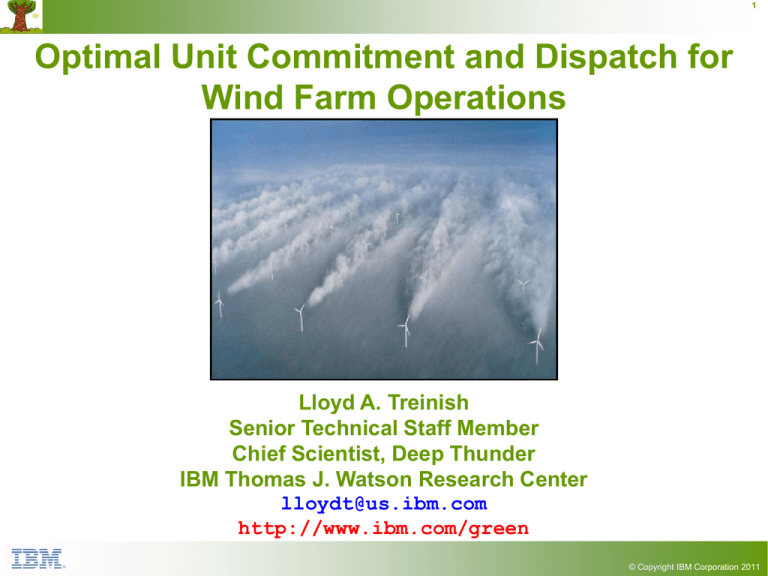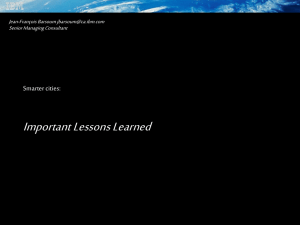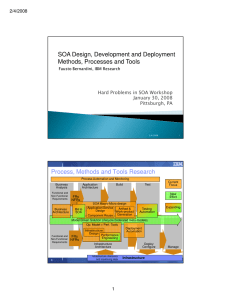Optimal Unit Commitment and Dispatch for Wind Farm Operations
advertisement

1 Optimal Unit Commitment and Dispatch for Wind Farm Operations Lloyd A. Treinish Senior Technical Staff Member Chief Scientist, Deep Thunder IBM Thomas J. Watson Research Center lloydt@us.ibm.com http://www.ibm.com/green © Copyright IBM Corporation 2011 2 Optimal Unit Commitment and Dispatch for Wind Farm Operations Background and motivation Approach Example experimental result Conclusions and future work © Copyright IBM Corporation 2011 3 Challenges for Wind Power Wind power intermittency creates significant barriers to expand utilization • Ramp events • Spinning reserve Better forecasting and smarter dispatch can reduce these barriers • Ensemble forecasts • Stochastic programming • Dynamic reserves © Copyright IBM Corporation 2011 4 Examples of Weather + Optimization Coupling Accurate timing of shut down due to severe weather –Lead time required to take preventative measures (e.g., when a storm hits the turbines must be shut down, which takes several minutes). –The shut down causes a loss of energy generation. –The more precise (or less uncertain) the weather forecasting the more optimal can the time of shutdown be determined to minimize the loss. Accurate reserve margins –With improved power estimations and when losses occur, the need for alternative sources (e.g., fossil fuel plants) can be better determined. –More cost effective management of all generators as the need for high margins on power reserves and standby production will decrease. Accurate area for shut down –Improved weather forecasting will allow a more limited shut down of the facility since a subset of the affected areas could be determined. Overall reduction in variability into the grid © Copyright IBM Corporation 2011 5 Unit Commitment and Dispatch Which power generators should be used, when and at what level in order to satisfy the demand for electricity? Conventional fossil-fueled or nuclear power generators require time and expense to power up and have limits on how quickly they can change their production levels. Unit commitment refers to deciding when to turn these generators on and off. Dispatch refers to deciding how much to produce from each generator. Because of the fixed costs and operating constraints on the generators, the power system has inflexibilities in dealing with unexpected load fluctuations and generator outages. To hedge against these uncertainties, system operators keep a certain amount of spinning reserve -- generators that are turned on but are producing at minimal levels so that they can increase production quickly. When the power system includes wind generators, the volatility of their output introduces additional uncertainty, requiring more spinning reserves, the cost of which detracts from the economics of using them. © Copyright IBM Corporation 2011 6 Approach Coupling of a numerical weather prediction (NWP) code to optimization software –Output used to define a range of potential wind forecasts and create a scenario tree to estimate the uncertainty in the prediction Essentially a linear programming problem with uncertainty in both supply (i.e., wind) and demand Use stochastic optimization to hedge the unit commitment decisions –Reduce the amount of spinning reserves required –Improve the dependability of the wind resource –Wind generation is treated implicitly as a reduction in the net demand on the conventional generators Validate with a model-based forecast of a ramping event © Copyright IBM Corporation 2011 7 Approach Required data –Set of electricity demands (loads) forecasted as a set of probabilistic scenarios for a ramping event –Set of generators (units) with several operating characteristics This leads to building recourse for each wind scenario and reduces the volume of spinning reserves as well as unmet demand and overall cost, regardless of the variance in the wind forecast The optimization model is a mixed integer linear program –It determines when to start up the generators –It assigns generators a production level for each time period, which may depend on the load scenario © Copyright IBM Corporation 2011 8 Weather Model Configuration WRF-ARW Community Model (v3.1.1) – Focused on the region of a wind farm with appropriate physics and sufficient vertical resolution in the boundary layer to capture details in the regime swept out by turbine blades – 18/6/2 km nests (76x76x42) – 84 hour runs twice daily (initialized at 0 and 12 UTC) since April 2009 – NAM for background and boundary conditions – WSM 6-class microphysics, YSU PBL, NOAH LSM, Grell-Devenyi ensemble, urban canopy model Select an off-shore location for “proposed” wind farm Identify simulation of ramping event from forecast archive – Interpolate wind data to 80m above sea level (assumed hub height of turbines for the “proposed” wind farm) © Copyright IBM Corporation 2011 9 Example “Wind Farm” Forecast for a Ramping Event Location of a hypothetical wind farm off the coast of New York City © Copyright IBM Corporation 2011 10 Example “Wind Farm” Forecast for a Ramping Event 84-hour wind forecast showing speed and direction at a height of 10m and at the location of a hypothetical wind farm off the coast of New York City along the blade extent as well as wind trajectories © Copyright IBM Corporation 2011 11 Example “Wind Farm” Forecast for a Ramping Event 84-hour wind forecast showing speed and direction at a height of 80m (top, i.e., hub height for turbines at the location of a hypothetical wind farm off the coast of New York City) and at height of 10m (bottom) Peak wind speed before the ramp down is close to the cutout speed of some turbines There is not lot of shearing from 10m to 80m because the off-shore flow is relatively laminar © Copyright IBM Corporation 2011 12 Variability of Wind Velocity and Power Across the Blade Extent 84-hour wind forecast showing speed and direction at the maximum blade height of 120m (top) and minimum blade height of 40m (bottom) There is not lot of shearing from 40m to 120m because the offshore flow is relatively laminar There is some variation in the wind speed along the full blade extent Three-dimensional, highresolution wind modelling is required to determine power accurately, given the vertical variability © Copyright IBM Corporation 2011 13 Variability of Wind Velocity and Power Across the Blade Extent 84-hour wind forecast showing speed and direction at the hub height of 80m (top) Given traditional wind turbine power curve, evaluate potential variation in power across the blade extent – P = 0.5A Cp x Ng x Nb x rv3, where r is the air density, v is the wind speed, A is the swept out area, Cp = Coefficient of performance, Ng = generator efficiency, Nb = gearbox/bearings efficiency 84-hour wind power forecast across the blade extent (maximum [red] vs. minimum height [blue]) relative to hub height (bottom) Significant variability in operating range (i.e., > 20mph), especially during and after the ramp down Associated uncertainty needs to be incorporated into power forecasts © Copyright IBM Corporation 2011 14 Sample Model Domain to Capture Variations in Ramp Location of a hypothetical wind farm off the coast of New York City and 8x8 samples at hub height (80m) to capture uncertainty due to phase errors © Copyright IBM Corporation 2011 15 Example Use Case: System Operator Perspective System operator has to adjust dispatch to account for variations in wind energy for a ramping event Consider the response to an unanticipated “ramp down” event (unanticipated at the 24 hours ahead unit commitment time) that will be predicted in the hour to two hour ahead time frame, allowing for recourse dispatch of other units to be accomplished –Will mitigate the effects of the large loss of supply, and be attributable to both the weather model forecasting ability and the optimization software’s ability to quickly rerun the dispatch case without that wind power Can use 24 hour unit commitment as normally done, then hourly dispatch for 4-8 hours ahead (instead of a full 24 hours to limit computation) –Choose generators with the proper ramp up times to fit this scenario A key financial aspect of this case is the ability to, over time, reduce spinning reserve on the system, based on growing confidence in both the accuracy of the day ahead forecast and, more importantly, confidence in the “day of” time frame, allowing a longer window for bringing up additional supply © Copyright IBM Corporation 2011 16 Example Use Case: System Operator Perspective Unit commitment with multiple net load scenarios 10 generating units with various characteristics – initial production level (the level at which it is operating when our schedule begins) – minimum (lowest amount of power the generator can produce on an on-going basis) and maximum generation level – minimum up and down times, the minimum number of hours a generator must be on (or off) once turned on (or off) – maximum ramp up and ramp down rates (the maximum amount that a generator can increase or decrease production in an hour) – start-up cost, from fuel consumption during that time – fixed cost incurred in each hour when the unit is running, regardless of the amount of power it produces – linear fuel consumption cost © Copyright IBM Corporation 2011 17 10-Unit Problem Deterministic model uses mean demand, explicit spinning reserve requirement Stochastic model builds recourse for each scenario, implicit (system) spinning reserve Type Min. Gen. (MWH) Max. Gen. (MWH) Min. U. Time Min. D. Time Ramp U. (MWH) Ramp D. (MWH) Startup Cost ($) Fixed Cost ($/time) Variable Cost($/MWH) COAL 100 425 15 9 212 183 5000 208.6 22.5 COAL 140 365 15 8 150 198 4550 117.4 32 GAS 78 220 6 7 101.2 95.6 1320 174.1 70.5 GAS 52 210 5 4 94.8 101.7 1291 172.7 69 GAS 54.25 165 5 3 58 77.5 1280 95.3 32.1 GAS 39 158 4 2 50 60 1105 144.5 54.8 DIESEL 17.4 90 3 2 40 24 560 54.4 40.22 DIESEL 15.2 87 3 2 60 45 554 54.5 40.5 DIESEL 4 20 1 1 20 20 300 79.6 116.3 DIESEL 2.4 12 1 1 12 12 250 16.2 76.6 © Copyright IBM Corporation 2010 18 Example Use Case: System Operator Perspective 85 time periods from the hourly weather model output from 20 of the sample points are used to represent the wind generation uncertainty – 1045 states reflecting temporal and spatial phase errors for the ramp event The load levels represent the net load after subtracting the output of the wind generators – Because of its near zero operating costs, it nearly always makes sense to use all of the available wind power The uncertainty in the load (due entirely to the volatility of the wind) is represented probabilistically by a scenario tree © Copyright IBM Corporation 2011 19 Example Use Case: System Operator Perspective A state represents the amount of net load at a point in time Multiple states at the same point in time represent alternative realizations of the load in different scenarios Solution identifies the best set of units to commit and the optimal production level for all units for all scenarios Eventually, spinning reserve could be scheduled as a function of wind power probability © Copyright IBM Corporation 2011 20 Modelling Wind Intermittency Demand is uncertain, i.e., dt is a random variable Wind energy is forecast using weather models – Wind speed and direction can be forecast but with uncertainty currently based upon spatial and temporal phase errors – For each farm, generation gi,t is a random variable Assume that wind energy (subject to cut-in constraints) has to be used (regulatory) – A must-take constraint Therefore, the total demand can be written as – Dt = dt –Sigi,t (a new random variable) – High-demand scenario is a ramp event © Copyright IBM Corporation 2010 21 Wind Intermittency and Ensemble Forecasting Transitions represent the uncertainty in the net load resulting from wind power volatility In a given state at a given hour, there may be multiple possibilities for the net load in the next hour From State ID Load Probability To State ID Load 0 1,112.958 0.388 1 1,102.072 0 1,112.958 0.179 2 1,191.000 0 1,112.958 0.149 3 1,152.175 0 1,112.958 0.224 4 1,134.028 0 1,112.958 0.060 5 1,165.991 Each possibility represents In state 0 above (representing the start of a transition the planning period) there are 5 possible transitions, shown above with their probabilities © Copyright IBM Corporation 2011 22 Scenario Tree A scenario is a sequence of states in chronological order, linked together by transitions All scenarios start at the same state and branches occur when there are multiple possibilities for the net load in the next period The boxes in the tree to the right represent states (e.g., period 22, load 1257 MW) The branches represent transitions (e.g., from state period 22, load 1257 MW) – 25% of the time a transition occurs to state period 23, load 1226 MW – 75% of the time a transition occurs to state period 23, load 1242 MW © Copyright IBM Corporation 2011 23 Power Production Total (conventional) power generation for each scenario Since the dispatch satisfies all the demand in each scenario, the total power generation equals the load © Copyright IBM Corporation 2011 24 Power Production During Ramping Event The stochastic optimization model will adjust to the changing demand profiles for all scenarios © Copyright IBM Corporation 2011 25 Deterministic Cases In the deterministic cases, the load in each period equals the expected value, or (ensemble) mean, over all the forecast scenarios in that period Hence, the forecast would typically represent the expected load However, in using an expected load forecast, system operators know that there are risks resulting form deviations from the forecast, such as ramp events To hedge against these risks, system operators keep a certain amount of spinning reserve, generators that are turned on but producing at minimal levels that can increase production quickly – The margin of spinning reserve required is usually defined as a percentage of the load – Usually, the reserve margin is specified in operating policies and is a fixed parameter, although operators may deviate from policy (sometimes requiring additional reserves) based on their judgment of these risks © Copyright IBM Corporation 2011 26 Deterministic vs. Stochastic Unit Commitment Lower-variance tree Explicit Reserves (%) Implicit (System) Reserves (%) 1 2 0 26.2 10 Unmet Demand (MWH) 2 3 4 Cost ($) 3 4 5 1 5 26.6 8.1 8.5 8.1 0 0 0 0 9.1 - 26.2 26.6 9.7 11.8 13.8 0 0 0 6.9 27.1 - 15 26.2 26.6 26.5 27 43.2 0 0 0 0 0 204,587 Stochastic 26.2 26.6 8.1 7.2 6.7 0 0 0 0 0 195,926 Higher-variance tree Explicit Reserves (%) Implicit (System) Reserves(%) Unmet Demand (MWH) Cost ($) 1 2 3 4 5 1 2 3 4 5 0 26.2 38.9 22.5 22.1 23.9 0 56.4 106.5 98.1 125.7 - 10 26.2 38.9 24.9 27.2 14.9 0 56.4 115.6 131.4 205.5 - 15-20 26.2 35.1 35.2 35.1 37.6 0 0 1.20 0 31.1 - 25 43.8 53.9 40 39.8 42.2 0 0 0 0 12.1 - 30 43.8 53.9 53.9 53.9 54.6 0 0 0 0 0 223,812 Stochastic 43.8 37.3 16.2 11.4 6.8 0 0 0 0 0 212,817 Both trees have the same mean, but higher variance in the lower tree makes a difference We would expect that more explicit/implicit reserves mean less unmet demand More explicit/implicit reserves in the lower tree result in more unmet demand Stochastic model has always less spinning reserves, less unmet demand and less cost, regardless of the variance © Copyright IBM Corporation 2011 27 Conclusions and Future Work Using a stochastic load forecast derived from NWP output, together with stochastic optimization substitutes analytic risk assessment for ad hoc adjustments to spinning reserves made based on operator judgment Stochastic unit commitment can achieve lower cost and comparable (or better) reliability to deterministic dispatch methods Predictive optimization with sufficient lead time can improve both dispatch and commitment Future work will include: – Use of true NWP ensemble to represent uncertainty in weather forecast – Including full three-dimensional representation of wind to determine power © Copyright IBM Corporation 2011 28 Backup Slides © Copyright IBM Corporation 2011 29 Physical & Digital Intelligence Applied to Smart Grids IT Intermittency Solution Coordinated control of centralized and distributed energy generation, transmission and storage with advance warning via forecasting and prediction from generation to user Physical & Digital Intelligence to Enable Forecasting & Prediction of Distributed Energy Generation NWP Modeling of Physical Systems High Quality Public + Private Data Wind Velocity Field Wave Intensity Input Sensor Array Pn = f (hn , Pn-m , Xn-m) Pn+q = F (hn , Pn+/-s , Xn+/-r) Computer Models for Primary Energy Conversion Technologies Grid Energy Forecast hn Stream Computing for Real-Time Model Parameter Estimators 1000 5 am 14 Win d Speed (m/s) Xn Forecast Model Drop in PV Output Solar Radiation Energy Conversion Model Solar Energy (W /m2) Weather Model Noon 7 pm Output Sensor Array © Copyright IBM Corporation 2011 IBM Research Unit Commitment Problem (Distributed Generation) DEMAND 24 48 CO2 EMISSION 72 PEAKING UNITS MINIMUM DOWN TIME BASE UNITS WIND SOLAR Integer programming problem with uncertain demand & supply -> Stochastic optimization The heat rate of a unit is a (nonlinear) function of load -> nonlinear optimization - maintenance improves heat rate and hence CO2 emissions 30 © 2009 IBM Corporation 31 Approach Mixed Integer Linear Programming (MILP) –Binary variables represent start-up and shut-down decisions –Continuous variables represent production level decisions –Variable production costs are piecewise linear –Cutting planes generated to strengthen linear representation of discreteness constraints Stochastic Programming with Recourse –Stage 1 (e.g., once per day): commit units with probabilistic scenarios for wind generation –Stage 2,…,n (e.g. 24 hours per day): dispatch committed units to serve load net of wind generation in each scenario (commitment does not change) –Replicated over 3-7 days –Bundle constraints represent non-anticipatory decision policies (i.e., current decisions cannot depend on foreknowledge of future) © Copyright IBM Corporation 2010 32 Modeling the Uncertainty – Scenario Tree s1 s1 s2 s2 (s1 s2 s3 s4 ) s3 t0 s3 s4 t1 s4 t2 A 24 to 72 hour weather forecast horizon is assumed © Copyright IBM Corporation 2011 33 Dynamic Decision Making Using Stochastic Programming Risks change dynamically Demand scenario trees 0.15 0.15 1197 1496 1227 1627 1 1158 1458 1207 1607 1 1207 1507 0.54 1207 1507 0.49 1197 1497 0.21 0.51 1188 1488 1196 1196 1217 917 0.49 0.09 0.50 1187 887 Mean:1196 1195 1 0.46 1197 897 1178 878 1158 858 2 1 0.54 0.21 0.20 t=1 0.46 3 1197 1 1 1139 1439 1207 1507 1158 858 1275 975 1178 878 1110 810 1236 936 1 1 1 1 1 1 1 1 1 1 1168 1468 1392 1692 1110 1410 1275 1575 1305 1605 983 683 1197 897 1207 907 1129 829 1236 936 4 5 1193 1210 • • • • • Values in the boxes show demand values for two scenario trees. Red line shows mean demand Values on the arcs represent probabilities. Both trees have equal means at each time period Lower demand values have higher variability – Forecast updates – Information sets Hedging risks – Recourse decisions Deterministic vs. stochastic decisions – Average case leaves unserved demand in extreme cases – Extreme cases overcompensate on reserves © Copyright IBM Corporation 2011





